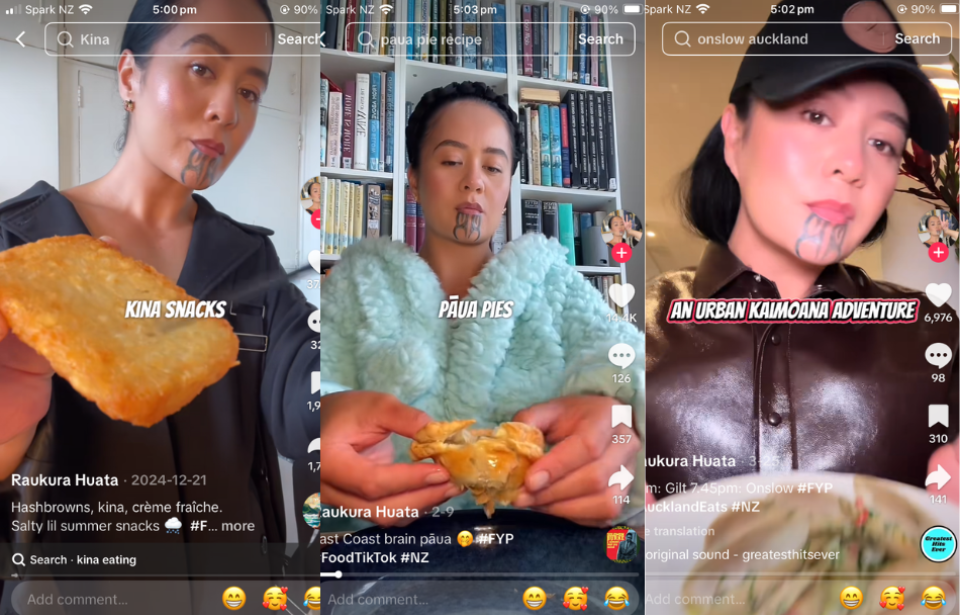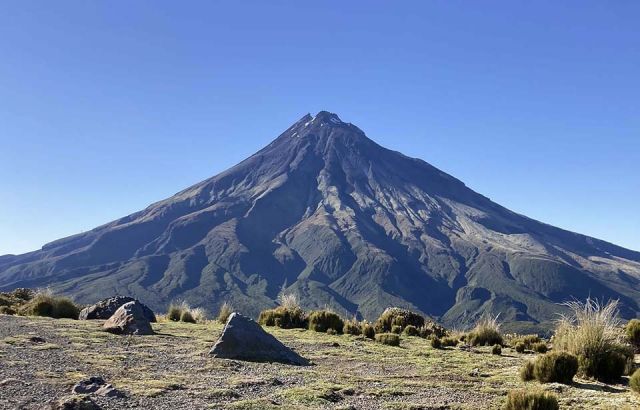TikTok kai content feeds cultural pride
• June 4, 2025

Raukura Huata has accumulated over 2.2 million likes on her TikTok account which features kai content. Photo: Screenshot / TikTok
Sharing kai on TikTok is helping Māori feel more connected to their culture, express pride in their identity and keep traditions alive.
That’s the finding from recent Massey University research, which analysed 100 TikTok videos tagged with ‘#Kai’ and ‘#Māori’ to explore how kai Māori content can support positive health messages in Māori communities.
Lead Researcher Dr Nikki Renall says the research shows people are using TikTok to “celebrate” Māori culture through the sharing of kai Māori content.
"I think it reflects that Māori are using TikTok in a very positive way, especially when it comes to kai Māori," Renall says.
“It's used as a form of cultural communication and connection to others that transcends geographical boundaries."
The TikTok content displayed people proudly eating kai Māori, sharing recipes and informing viewers on Tikanga around kai.
Renall said the response to the videos was “overly positive,” with many people from overseas viewing the kai Māori content.
“They could, wherever they were, just connect to Te Ao Māori and sort of uplift their Mauri from engaging with it [the content].”
Findings were categorised into three themes: “Mauri ora (kai as an expression of pride in Māori identity), Ahikā kai (a means of keeping traditions alive) and Tūhononga (a means of connecting with Te Ao Māori).”
Content creator Raukura Huata uses TikTok to share videos that blend her passion for kai and culture.
Huata says her content is “a lens into the beauty of Te Ao Māori”, which she shares with her 90,000 followers.
“What are the things that make our cuisine so fundamentally unique? I don't necessarily think that it's an ingredient or a specific technique, but rather a set of mātāpono,” she says.
“It is the philosophy about how we are gathering, how we are planting, whether we're considering the sustainability of land, ocean, wai Māori.
“These are techniques of my tīpuna that I still practice and promote today.”
The research project identified 20 food types that were strongly connected to Māori identity, including kaimoana, hāngi and boil up.
Kaimoana – such as kina, pāua and fish – feature prominently among Huata’s content. She often shows her preparation process before eating kai and also shares videos trying seafood cuisines at popular restaurants.
“Kaimoana is such a delicacy and also I'm a coasty, so these are my ancestral foods,” she says.
“[I appreciate] hearing how Māori who have engaged in my content are reclaiming their Māori palette and consider some of the kai that I eat as kai of the old people.”
Huata views her TikTok content as an expression of identity, but “also an expression of hope for the wellbeing of our people”.
Hauora is a Māori philosophy that acknowledges the interconnectedness of the physical, mental, social, emotional and spiritual elements of a person.
Renall highlights that health promotion among Māori communities requires all elements to be considered and the TikTok content reiterates this; it shows the holistic value Māori associate with kai.
“As health professionals and nutrition professionals, we need to be thinking about how we communicate about it [food]. It’s not just nutrients. It actually touches on all domains of well-being.”
The research project found that videos frequently showcased traditional food gathering practices which support hauora, such as whānau diving for kaimoana and collecting watercress.
Huata also says that food harvesting content promotes food sovereignty and platforms safety and Tikanga around food gathering.
“I hope that it normalises it amongst that particular demographic [young people].
“They're going to be the champions of not only our cuisine but our reo and all things that make Māori so beautiful.”

Whakatairanga ka tika, whakamaua ngaa mita
AISHA CAMPBELL (NGĀTI RUANUI, NGĀ RAURU, NGĀ RUAHINE, TE ATIAWA, TARANAKI) • October 28, 2025

Supporters hope new council will save Western Springs Speedway
Savannah Lendich Jonkers • October 8, 2025


Whakatairanga ka tika, whakamaua ngaa mita
AISHA CAMPBELL (NGĀTI RUANUI, NGĀ RAURU, NGĀ RUAHINE, TE ATIAWA, TARANAKI) • October 28, 2025

Supporters hope new council will save Western Springs Speedway
Savannah Lendich Jonkers • October 8, 2025
